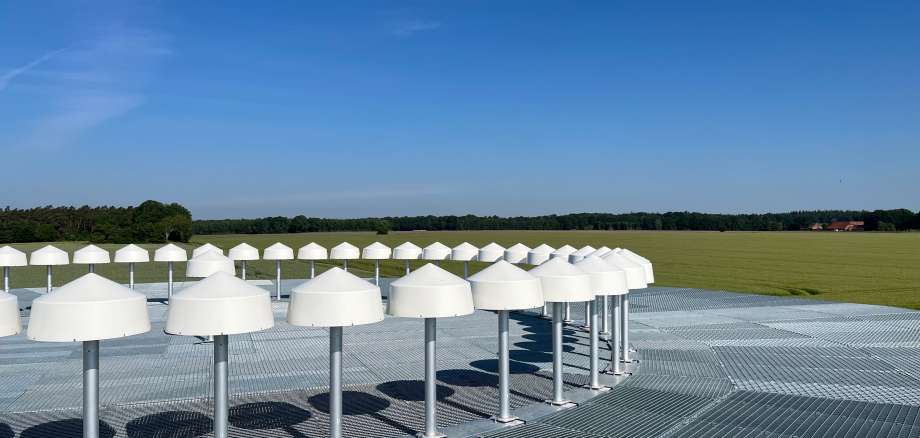DFS, the German air navigation service provider, is putting the Nienburg navigation aid for aircraft back into operation on 28 June following its conversion to a Doppler omnidirectional radio beacon (DVOR). The new DVOR is significantly less sensitive to interference from wind turbines compared to the previously used conventional type, known as CVOR. The so-called building restricted area set up to protect the navigation aid’s signals can now be reduced from a radius of 15 to 7 kilometres. This corresponds to a 75-percent reduction in the protected area required. This reduction frees up more space for the expansion of wind energy in the Hanover Region, a district in Lower Saxony, Germany.
"The Neustädter Land is a focal point of wind energy expansion in the Hanover Region. We are delighted that the constructive dialogue with DFS has led to the prospect of making almost 900 hectares of additional land available for wind power there," reported Jens Palandt, departmental head for environment, climate, planning and construction for the Hanover Region.
The Region aims to become climate neutral as quickly as possible and has designated almost 2.5 percent of its area as priority areas for wind energy use. Based on current calculations, the Region needs around 4,700,000 megawatt hours of electricity from wind energy every year to achieve its climate targets. Around 13 percent of this could also be made available thanks to the conversion of the omnidirectional (rotating) radio beacon in Neustädter Land.
"This is a tangible contribution to the energy transition and will help us to cover our electricity needs entirely from renewable energies as quickly as possible," said the departmental head.
DFS, the Hanover Region and the district of Nienburg have been working together since 2019 to harmonise the interests of wind power expansion and reliable navigation signals for airspace users.
"During the three-year pilot project called Flight Safety Issues in Regional Planning, we were able to support the regional planners of the Hanover Region with model calculations to designate priority areas for the expansion of wind power," explained Dr Morten Grandt, Head of Navigation Services at DFS. "The knowledge gained in the process was incorporated into new procedures, on the basis of which DFS is now working with planning authorities throughout Germany."
German Federal Government provides financial support
In Germany, there are 48 omnidirectional radio beacons currently in operation, comprising 40 Doppler omnidirectional radio beacons (DVOR) and a further 10 conventional radio beacons (CVOR). These CVORs, which are more susceptible to interference from wind turbines, are being converted to less sensitive DVORs or dismantled entirely with the financial support of the German Federal Government, as with the former CVOR Nienburg. (The only exception to this programme is the facility on the island of Heligoland.)
With the introduction of modern, primarily satellite-based navigation procedures, 22 (of around 70) omnidirectional radio beacons have already been decommissioned since 2002. The dismantling is being pursued throughout Europe down to a basic skeleton of omnidirectional radio beacons. This is needed as a backup infrastructure in case satellite signals are unavailable or disrupted. The two DVORs in Nienburg and Sarstedt in the Hanover Region are part of this backbone.
"As the recent cases of disruption to the GPS satellite navigation system in the Baltic Sea region have shown, we are well advised to maintain ground-based redundancy for navigation in airspace," emphasised Grandt.
21,000 square kilometres boost for wind power expansion
Based on a joint initiative of DFS, the German Federal Ministry for Economic Affairs and Climate Action (BMWK) and the Ministry for Digital and Transport (BMDV) in February 2023, the protected areas of all Doppler omnidirectional radio beacons have been reduced from a radius of 15 to 7 kilometres. DFS is thus freeing up an area almost half the size of Lower Saxony (21,000 square kilometres) for the expansion of wind power.
The reassessment of the protected area around air navigation facilities was the result of new scientific findings. DFS and the National Metrology Institute of Germany (PTB) jointly established these findings within the framework of the WERAN research project on the interaction of wind turbines and radar/navigation funded by the BMWK. The objective was to ensure the interference-free operation of air navigation facilities, while taking energy policy concerns into account to the greatest possible extent.
Downloads
DFS media contact
Anja Naumann
Telephone: +49 (0)421 / 5372-116
E-mail: presse@dfs.de
Hannover Region media contact
Philipp Westphal
Telephone: +49 (0)511 / 616 -22729
E-mail: philipp.westphal@region-hannover.de
DFS Deutsche Flugsicherung GmbH (DFS), the German air navigation service provider, is a State-owned company under private law with 5,700 employees as at 31 December 2023. DFS ensures the safe and punctual flow of air traffic over Germany. Around 2,200 air traffic controllers guide more than three million flights through German airspace in peak years, up to 10,000 every day. The company operates control centres in Bremen, Karlsruhe, Langen and Munich as well as control towers at the 15 designated international airports in Germany. The subsidiary, DFS Aviation Services GmbH, markets and sells products and services related to air navigation services, and provides air traffic control at nine regional airports in Germany and at Edinburgh Airport in the United Kingdom. DFS is working on the integration of drones into air traffic and has set up a joint venture, Droniq GmbH, with Deutsche Telekom. Other subsidiaries include R. Eisenschmidt GmbH, which markets publications and products for general aviation, and Kaufbeuren ATM Training GmbH (KAT), which provides training for military air traffic services personnel. The joint venture FCS Flight Calibration Services GmbH offers flight inspection services.
